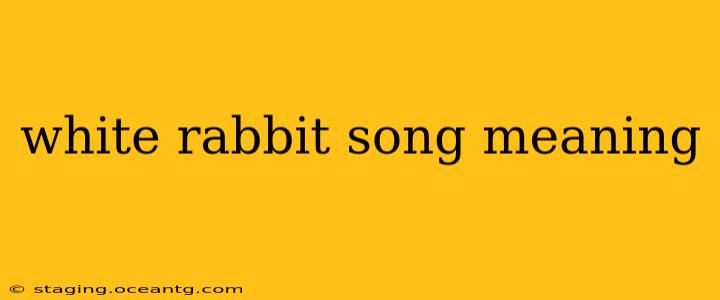Jefferson Airplane's "White Rabbit," a psychedelic anthem from their 1967 album Surrealistic Pillow, remains a timeless classic, captivating listeners with its haunting melody and enigmatic lyrics. While Grace Slick's vocals paint a vivid picture of Alice's adventures in Wonderland, the song's meaning transcends a simple children's story, delving into deeper themes of drug use, societal control, and the search for enlightenment. This exploration dives into the song's multifaceted interpretations, addressing common questions surrounding its meaning.
What is the main message of White Rabbit?
The central message of "White Rabbit" is a cautionary tale about the dangers of losing oneself in the pursuit of altered states of consciousness. The song cleverly uses Lewis Carroll's Alice's Adventures in Wonderland as an allegory for the psychedelic experience. Alice's journey down the rabbit hole mirrors the descent into altered realities, where perceptions shift and boundaries blur. The lyrics subtly suggest that while the pursuit of enlightenment or escape can be tempting, it carries inherent risks and can lead to unforeseen consequences. The "one pill makes you larger, and one pill makes you small" line particularly encapsulates this duality, representing the unpredictable nature of drug-induced experiences.
What are the different interpretations of White Rabbit?
Beyond the overt theme of drug use, "White Rabbit" allows for multiple interpretations, depending on the listener's perspective and experiences. Some see it as a commentary on societal control and conformity, with the rabbit representing an escape from the constraints of a rigid social structure. Others interpret it as a more spiritual journey, with the psychedelic experience representing a search for self-discovery and enlightenment, albeit a risky one. The ambiguity of the lyrics allows for a wide range of interpretations, making the song perpetually relevant and captivating.
Is White Rabbit about LSD?
While the song doesn't explicitly mention LSD, its allusions to altered states of consciousness, hallucinations, and the unpredictable nature of the experience strongly suggest a connection to psychedelic drug use, particularly LSD. The popularity of LSD during the 1960s, the era in which the song was written and released, further supports this interpretation. The imagery of the rabbit hole, the shifting landscapes, and the overall feeling of disorientation all align with the effects commonly associated with psychedelic drugs.
What does the line "Feed your head" mean in White Rabbit?
The iconic line "Feed your head" is a direct encouragement to expand one's consciousness, either through psychedelic experiences or intellectual exploration. It encourages listeners to actively seek knowledge, challenge their beliefs, and think critically. However, the context of the song suggests a cautionary tone even within this encouragement. "Feeding your head" can lead to positive self-discovery but also carries the risk of losing control and succumbing to the negative consequences of substance abuse or unchecked experimentation.
What is the symbolism of the White Rabbit in White Rabbit?
The white rabbit in "White Rabbit" acts as a multifaceted symbol. It represents the allure of the unknown, the temptation of altered realities, and the guide into a world beyond ordinary perception. The rabbit's appearance leads Alice, and by extension the listener, down a path of transformative experiences, both positive and potentially negative. Its whiteness could symbolize purity or innocence, which are juxtaposed with the darker implications of the psychedelic journey.
How does White Rabbit use Alice in Wonderland as an allegory?
Jefferson Airplane masterfully uses Alice's Adventures in Wonderland as a framework to explore the themes of altered consciousness. Alice's journey down the rabbit hole becomes a metaphor for the descent into psychedelic experiences. The ever-changing landscapes, the illogical encounters, and the overall sense of disorientation mirror the effects of drugs. The song borrows heavily from Carroll's imagery, using it to create a compelling and evocative narrative of self-discovery and the potential pitfalls of the journey.
In conclusion, "White Rabbit" is a multi-layered masterpiece that transcends its initial interpretation. It serves as a timeless reminder of the risks and rewards inherent in the pursuit of altered states of consciousness, using the familiar imagery of Alice in Wonderland to explore profound themes of societal control, self-discovery, and the ever-present duality of human experience. Its enduring popularity speaks to its ability to resonate with listeners on multiple levels, making it a truly iconic piece of musical history.
